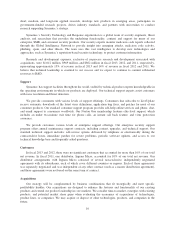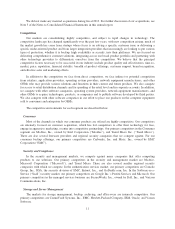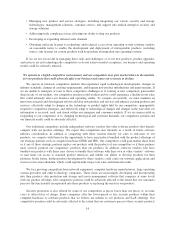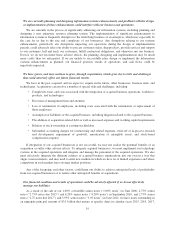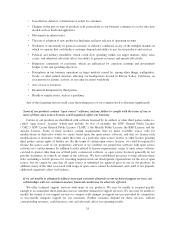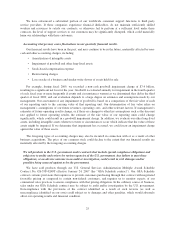Symantec 2013 Annual Report Download - page 114
Download and view the complete annual report
Please find page 114 of the 2013 Symantec annual report below. You can navigate through the pages in the report by either clicking on the pages listed below, or by using the keyword search tool below to find specific information within the annual report.We have begun investing in a plan to better meet customer needs through internal innovation and driving
faster organic growth, with a particular focus on key areas that combine our existing products and services
into new solutions that are designed to meet multiple customer needs with integrated higher value offerings,
and if the return on these investments is lower or develops more slowly than we expect, our operating results
may be harmed.
Pursuant to our recently announced restructuring plan, we have been reallocating talent within our
organization and are dedicating spending and resources to focus on certain key areas, such as mobile workforce
productivity, Norton protection, Norton cloud, information security services, identity/content-aware security
gateway, data center security, business continuity, integrated backup, cloud-based information management and
object storage platform. We expect research and development expenses to increase through fiscal 2017 as we
invest to drive organic innovation for our customers. While we will seek to have the right level of investment and
the right level of resources focused on our biggest growth opportunities, the return on these investments may be
lower, or may develop more slowly, than we expect. If we do not achieve the benefits anticipated from these
investments (including if our selection of areas for investment does not play out as we expect), or if the
achievement of these benefits is delayed, our operating results may be adversely affected.
Over the long term we intend to invest in engineering, sales, service, marketing and manufacturing
activities, and these investments may achieve delayed, or lower than expected, benefits which could harm
our operating results.
While we intend to focus on managing our costs and expenses, over the long term, we also intend to invest
in research and development activities as we focus on organic growth through internal innovation. We are likely
to recognize the costs associated with these investments earlier than some of the anticipated benefits, and the
return on these investments may be lower, or may develop more slowly, than we expect. If we do not achieve the
benefits anticipated from these investments, or if the achievement of these benefits is delayed, our operating
results may be adversely affected.
Defects or disruptions in our SaaS offerings could reduce demand for our services and subject us to
substantial liability.
Our SaaS offerings may contain errors or defects that users identify after they begin using them that could
result in unanticipated service interruptions, which could harm our reputation and our business. Since our
customers use our SaaS offerings for mission-critical protection from threats to electronic information, endpoint
devices, and computer networks, any errors, defects, disruptions in service or other performance problems with
our SaaS offerings could significantly harm our reputation and may damage our customers’ businesses. If that
occurs, customers could elect not to renew, or delay or withhold payment to us, we could lose future sales or
customers may make warranty or other claims against us, which could result in an increase in our provision for
doubtful accounts, an increase in collection cycles for accounts receivable or the expense and risk of litigation.
Risks related to the provision of our SaaS offerings could impair our ability to deliver our services and
could expose us to liability, damage our brand and reputation or otherwise negatively impact our business.
We currently serve our SaaS-based customers from hosting facilities located across the globe. Damage to, or
failure of, any significant element of these hosting facilities could result in interruptions in our service, which
could harm our customers and expose us to liability. Interruptions or failures in our service delivery could cause
customers to terminate their subscriptions with us, could adversely affect our renewal rates, and could harm our
ability to attract new customers. Our business would also be harmed if our customers believe that our SaaS
offerings are unreliable. As we continue to offer more of our software products in a SaaS-based delivery model,
all of these risks could be exacerbated.
Our SaaS offerings also involve the storage and transmission of large amounts of our customers’ proprietary
information, including sensitive and personally identifiable information. Breaches of our security measures or the
16






